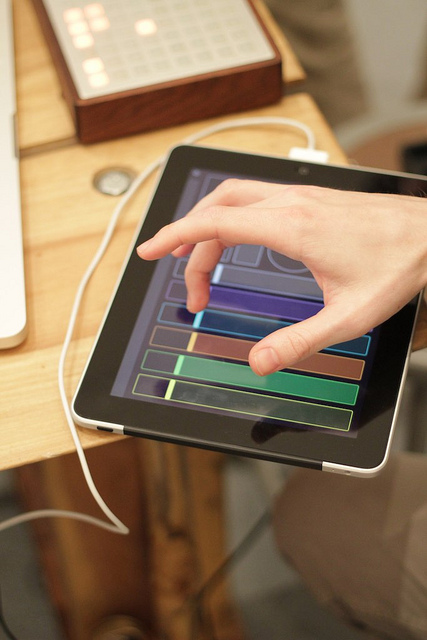
TouchOSC has become something of a standard on iOS for touch control, thanks to desktop editor apps for custom layouts and high-contrast, Lemur-style controls. Last Thursday was all about wired MIDI on iPad, so it seems only fair to show what people are doing with wireless and OSC. I’ve got a few good selections from my recent inbox.
DJing with Traktor
Above, the latest version of Traktor Pro templates, for iPhone or iPad, from Milos:
http://androidosc.blogspot.com/
It’s got some extensive functionality, and since Milos used Pure Data (Pd) to translate to MIDI, you can use it with both the Mac and Windows versions of Traktor. Milos doesn’t yet have an iPad, so he’s collecting money to invest in one.
Arovia has their own Traktor layout, aptly titled “nano” as it’s fit into a small area.
From over the summer, here’s a different approach to using Traktor with touch, turning instead to one big wheel.
Ableton Live
Malaventura has assembled a “kitchen sink” approach to working with Ableton Live, with a do-everything Live template.
A touchOSC layout for iPad that contains a step sequencer monosynth & drum machine, a ambient generator, a psychedelic fx unit & operator synth controller. All designed for works in iPad with touchOSC, OSCulator and Ableton Live in your computer. The layout and all the files necessary are zipped in this link:
http://www.archive.org/details/MalaventuraTouchoscSuite
It’s a really involved set of layouts; it’s not quite as sophisticated as something dedicated like Touchable, but then again, since you can run both, you may just give it a try and use it for certain editing workflows.
The one caveat – and this is a catch on a lot of these patches – is that you need Osculator in order to use it. More on that gripe in a moment.
Working with Hardware
Last week, I showed my preferred means of editing MIDI devices – using, you know, MIDI cables. But I can see the appeal of wireless control, too, in certain situations. Using The Missing Link wireless hardware adapter (see our detailed look at two wireless solutions last month), you can work with conventional hardware.
Via Matrixsynth, there’s a nice template for the Waldorf Pulse.
Palm Sounds points to a Yamaha DX7 editor, complete with SysEx. (Isn’t there supposed to be an actual link there somewhere, though?)
Some Friendly Criticism of the State of OSC Touch
I do see opportunity for progress in all of this, however. Constructive criticism, for all of us:
- The lack of native OSC means way, way too many kludges. Osculator is a cool little app, but you shouldn’t need it to do OSC; the whole point of OSC is that it’s a simple, universal networking protocol. We either need native support in apps like Ableton Live, or we need to use something else – period. Having to use go-between apps makes it a step backward in these applications from MIDI.
- Why not edit on the device, or even generate layouts automatically? Part of the beauty of touch layouts is on-the-fly controls. There’s plenty to explore here, from layouts that generate automatically after an exchange of information over OSC to on-device editing. One of my criticisms of the original Lemur was having to use a dedicated editing app, and that was more than five years ago.
- Why not use the browser? Wouldn’t it be great for editing and control to move seamlessly between desktop browser and mobile, or between mobile platforms?
I’m burying this in this article just because I’d rather spend time working on those things than complaining them, but it’s worth saying, partly because I’m sure others are thinking the same way. (And developers thinking that way have the chops to do something about it.)
Also, in answer to everyone griping about a good Android solution, I’m personally waiting for a usable Android tablet and not just handhelds. That means I’m seriously bummed that the Motorola Xoom may cost US$800. Sorry, at that point, I spend money on synths instead.
Knobs rock.
All of that said, I do think there are some great solutions here, and they work right now. Looking forward, we can build the next generation even better.
In the meantime, go grab TouchOSC. It’s fantastic software, and supporting it means an increased likelihood of developer hexler getting to continue to iterate on his own great work. (He’s a really nice guy, to boot, as well as a talented developer; I know he isn’t exactly getting rich on this thing, but sales really do support developers working on apps they care about.)
http://hexler.net/software/touchosc
What layouts are you using? Got any you want to share? And what do you want to see in touch controllers?